How to build an NFS file sharing server on Ubuntu 16.04
NFS stands for Network File System (Network File System), which is a distributed file system protocol, which allows client hosts to access server-side files through the network like a local file system. That is, the remote server files can be directly mount (mounted) to the local file directory structure for access.
1. Software installation
The server side needs to install the nfs-kernel-server software package:
$ sudo apt-get update
$ sudo apt-get install nfs-kernel-server
Two, server configuration
By default, if a shared directory is defined on the NFS server, all files in the directory and its subdirectories can be accessed.
For security considerations, any file operations on the client that require super user (ie root user, UID=0 & GID=0) permissions are mapped to UID=65534 and GID=65534 by default User, that is nobody:nogroup in Ubuntu system.
For example, when the client uses root privileges to create a file in a mounted shared directory, the owner and group of the file will automatically become nobody:nogroup instead of root: root.
- Create a shared directory on the server side
sudo mkdir -p /var/nfs/gernel
sudo mkdir -p /var/nfs/public
sudo chown nobody:nogroup /var/nfs/gernel
- Modify the exports file
In order to make the shared file defined by the NFS server accessible by the specified client host, you need to add the corresponding record in the /etc/exports file on the server side.
The format of the file is as follows:
Directory Host(Options ...) Host(Options) #comment For the detailed syntax and format of the /etc/exports file, please refer to man exports.
File example:
/var/nfs/gernel 192.168.56.0/24(rw,insecure,sync,no_subtree_check)/var/nfs/public*(ro,insecure,sync,no_subtree_check)/home/starky 192.168.56.1(rw,insecure,no_root_squash,sync,no_subtree_check)
The first record indicates that all hosts in the 192.168.56.0/24 subnet can mount the var/nfs/gernel directory and have read and write (rw) permissions
The second record indicates that all hosts can mount the /var/nfs/public directory and have read-only (ro) permissions
The third record indicates that the host with the client IP address 192.168.56.1 can mount the /home/starky directory and has read and write permissions, and any file with root permissions (UID=0, GID=0) Operations are not mapped to nobody:nogroup by default, and the owner (group) remains root (no_root_squash)
insecure option: allow remote access through any port
Sync option: Force the NFS server to write file changes to disk before responding to the request (emphasizes the consistency of the file content between the client and the server, but it will reduce the efficiency of file operations).
no_subtree_check option: Disable subtree_check. subtree_check is used to set the server to check whether the file is still available in the specified directory structure when receiving a request (this option will cause an error in some cases: when a file is renamed, the file is opened on the client side).
Three, the client mounts the shared directory
List shared directories on the nfs server
$ showmount -e 192.168.56.102
Exports list on 192.168.56.102:/home/starky 192.168.56.1/var/nfs/public*/var/nfs/gernel 192.168.56.0/24
Create mount point
sudo mkdir -p /mnt/nfs/gernel
sudo mkdir -p /mnt/nfs/public
sudo mkdir -p /mnt/nfs/starky
Mount remote directory
sudo mount 192.168.56.102:/var/nfs/gernel /mnt/nfs/gernel
sudo mount 192.168.56.102:/var/nfs/public/mnt/nfs/public
sudo mount 192.168.56.102:/home/starky /mnt/nfs/starky
Permission test
As shown in the screenshot:
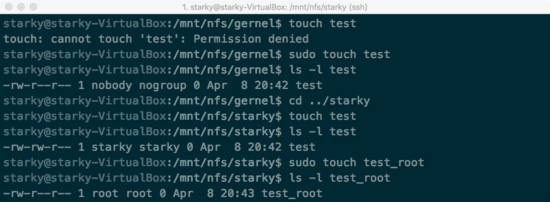
nfs permission test
The permission setting of NFS is based on the permission management of the Linux file system, that is, after the client mounts the remote shared directory, it will treat them as a local disk directory, which is also based on the file owner (group) and the corresponding permission setting. Restrict access.
The owner (group) of the gernel directory is nobody:nogroup (65534:65534), so although the directory has read and write permissions, non-root users cannot perform new operations. The root user is automatically mapped to nobody:nogroup due to the default security mechanism of NFS.
Since I have a user named starky on the client and server, and their UID:GID is 1000:1000, the /home/starky directory on the server can be directly accessed by the starky user on the client. And because of the no_root_squash option, the owner of the file created by the sudo command is still root (and will no longer be mapped to nobody).
Of course, this will cause some security problems. For example, if multiple clients have users with a UID (GID) of 1000 at the same time (regardless of the user name), these users will share the file permissions in the /home/starky directory on the server .
Four, the shared directory is automatically mounted when the system starts
The /etc/fstab file can be edited to make the mount operation of mounting a shared directory a fixed configuration of the system (mount command entered manually is a temporary mount and will be automatically unmounted after restart), so that the system can be automatically mounted after restart Load remote file system. The sample content of the /etc/fstab file is as follows:
# filesystem mountpoint fstype flags dump fsck
192.168.56.102: /var/nfs/gernel /mnt/nfs/gernel nfs rw,bg,intr,hard,nodev,nosuid 00192.168.56.102:/var/nfs/public/mnt/nfs/public nfs4 ro,bg,intr,soft,nodev,nosuid 00192.168.56.102:/home/starky /mnt/nfs/starky nfs rw,bg,intr,hard,nodev,nosuid 00
appendix:
appendix:
1. Host format in the /etc/exports file
The format of the /etc/exports file is: Directory Host(Options ...) Host(Options) #comment
The Host item is used to specify the host that can access the corresponding shared directory, and its format can be divided into the following types:
Single host
The Host item can be one or more individual TCP/IP host names or IP addresses
admin
admin.starky.net
192.168.56.101
IP subnet
10.0.0.0 /255.0.0.0172.16.0.0/255.255.0.0192.168.56.0/24
TCP/IP domain
By using wildcard, you can specify all or part of the hosts in a specific domain
*. starky.net
* craft.starky.net
???. starky.net
NIS group
You can specify the access permissions of all hosts in a certain NIS group, using @group
**2. Options ** in the /etc/exports file
| Option | Description |
|---|---|
| ro | read-only access |
| rw | Read and write permissions (default) |
| rw=list | Specify a client host with write permission through list, and other hosts have read-only permission |
| root_squash | Map UID 0 and GID 0 to anonuid and anongid (ie nobody and nogroup in Ubuntu system) |
| no_root_squash | Allows file operations that require root permissions, there is a security risk |
| all_squash | Map all UIDs and GIDs to their anonymous form, mainly for untrusted hosts |
| anonuid=xxx | Specify the UID that needs to be mapped to the operation of the client's root authority (the default is 65534) |
| anongid=xxx | Specify the GID that needs to be mapped to the operation of the client's root authority (the default is 65534) |
| insecure | Allow remote access through any port |
| async | The server can respond to client write requests before writing to the hard disk |
| wdelay | Synchronize file updates from multiple clients by delaying |
| sec=flavor | Specify the security authentication method of the shared directory, including sys (UNIX authentication), dh(DES), krb5i, krb5p and none (anonymous access) |
3. NFS mount options
| Option | Description |
|---|---|
| rw | Mount the file system in read-write mode (rw also needs to be defined on the server side) |
| ro | Mount the file system in read-only mode |
| bg | If the mount fails (the server does not respond), continue to try and execute other mount requests in the background |
| hard | If the server does not respond, repeat the request until the server replies |
| soft | If the server does not respond, repeat the request and return an error after a certain period of time without blocking all the time |
| intr | Allow users to interrupt blocked file operations (and return an error) |
| nointr | Do not allow users to interrupt client file operation requests |
| retrans=n | In soft mode, specify the number of times to repeat the request before returning an error |
| timeo=n | Set the time interval to repeat the request after timeout (unit 1/10 second) |
| rsize=n | Set the read buffer size to n bytes |
| wsize=n | Set the write buffer size to n bytes |
| sec=flavor | Set the security verification method |
| proto=proto | Set the transmission protocol, NFSv4 must be TCP |
4. NFS protocol discussion
Transfer Protocol
The original NFSv2 used the UDP protocol for performance reasons. Although NFS added its own packet sequence reorganization and error checking functions, neither UDP nor NFS have the blocking control algorithm, so in large Lack of sufficient performance in the Internet environment.
NFSv3 provides a choice between UDP and TCP protocols. NFSv4 can only use the TCP protocol.
With the increase of CPU, memory and other hardware devices and network transmission speed, the initial preference for UDP protocol due to performance requirements becomes no longer necessary.
State
NFSv2 and NFSv3 are stateless connections. The server does not track the client's mounting of the shared directory, but uses "cookies" to record a successful mount. "Cookie" will not be deleted because the server restarts, and can be used to retain the client's connection information after the server is down.
NFSv4 is a state connection. Both the client and the server maintain file operation records and file lock status. So the use of "cookies" is no longer needed.
File lock
Earlier versions of the NFS protocol (v2 & v3) are stateless connections, and they don't know which hosts are using which files. But the realization of the file lock needs to obtain the status information. Therefore, the file lock in the early protocol is implemented independently of NFS.
NFSv4 integrates the implementation of file locks into the core protocol. Although this increases complexity, it also solves many problems in the earlier version.
But in order to be compatible with clients using V2 and V3 protocols, independent locked and statd daemons are still required.
Safety related
The NFS protocol initially did not pay attention to security when it was designed. NFSv4 strengthened the security of the protocol by introducing support for stronger security services and identity verification.
The traditional NFS protocol mostly uses AUTH_SYS authentication, based on UNIX user and group identification. In this way, the client only needs to send its UID and GID and compare them with the contents of the /etc/passwd file on the server to determine what permissions it has.
So when multiple clients have users with the same UID, these users will have the same file permissions. Furthermore, users with root privileges can switch to any UID login through the su command, and the server will give them the corresponding UID privileges.
In order to prevent the above problems, the server can choose to use a more robust authentication mechanism such as Kerberos combined with NFS PRCSEC_GSS.
The access control of NFS shared directories is based on the host name or IP address defined in the /etc/exports file. But the client can easily falsify its identity and IP address, which can also cause some security problems.
NFSv4 only uses TCP as its transmission protocol, and usually only opens port 2049 for data transmission. When configuring the firewall, in addition to letting go of the 2049 port limit, you must always pay attention to the source and destination addresses of data transmission.
5. Windows system mount shared directory
The win10 system cannot mount NFS shared directories by default. You need to enter the control panel-Programs-Programs and Features-enable or disable Windows functions, and check NFS Service.

Enable nfs service
Then you can use the mount command to mount the shared directory.
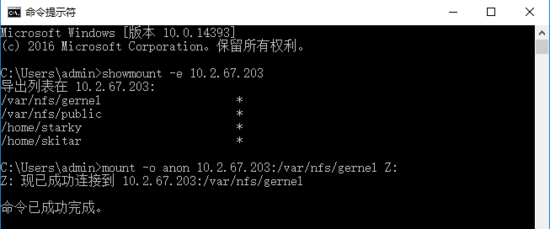
mount command to mount a shared directory
It's just that the Windows system does not use user management like Linux, so the mounted shared directory can only be read but not written.
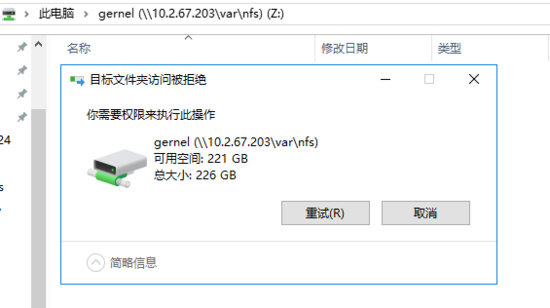
Cannot write file
The solution is to create two DWORD values in the registry to be used as the UID and GID of the anonymous user.
The mount options under the default parameters, UID and GID are both -2:
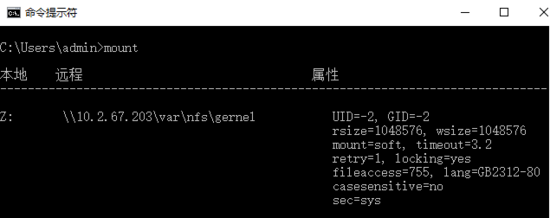
Default mount options
You can enter regedit (regedit), navigate to HKEY_LOCAL_MACHINE\SOFTWARE\Microsoft\ClientForNFS\CurrentVersion\Default, create two new DWORDs named AnonymousUid and AnonymousGid (32-bit) value, change it to the number you need to use (I changed it to 0, which corresponds to the root user in the Linux system. If you need to change it to a number other than 0, pay attention to first convert it to 16).
The mount options at this time become:
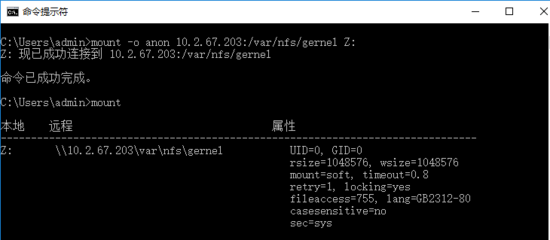
Change UID and GID
If the change does not take effect, restart the computer.
Reference materials
UNIX and Linux System Administration Handbook, 4th Edition
How to Mount an NFS Share Using a Windows 10 Machine
The above is the whole content of this article, I hope it will be helpful to everyone's study.
Recommended Posts